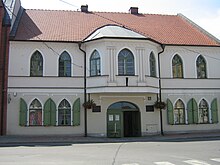Wolsztyn
Wolsztyn | |
|---|---|
 Parish church | |
| Country | |
| Voivodeship | Greater Poland |
| County | Wolsztyn County |
| Gmina | Gmina Wolsztyn |
| Area | |
| • Total | 4.78 km2 (1.85 sq mi) |
| Population (2006) | |
| • Total | 13,557 |
| • Density | 2,800/km2 (7,300/sq mi) |
| Postal code | 64-200, 64-201 |
| Website | http://www.wolsztyn.pl |
Wolsztyn [ˈvɔlʂtɨn] (Template:Lang-de) is a town in western Poland, on the western edge of Greater Poland Voivodeship (from 1975 to 1998 it was in Zielona Gora Voivodeship). It is the seat of Wolsztyn County, and of the smaller administrative district of Gmina Wolsztyn.
Geography
The town is situated within the historic Greater Poland region, located on the small Dojca river, a headstream of the Obra, about 72 kilometres (45 mi) southwest of Poznań.
The municipal area includes a large lake (Jezioro Wolsztyńskie; Wolsztyn Lake), next to which is a former palace built in Classical style in the early 20th century, now used as a hotel and restaurant, and a park. Nearby tourist destinations include the Pszczew Landscape Park and the Przemęt Landscape Park.
History
The current settlement was established about 1285 on a causeway across the swampy Dojca River, probably by Cistercian monks descending from Obra Abbey. It developed as a centre of wool (German: Wolle) trade and cloth manufacturing on the road from Poznań to Lusatia, vested with market rights in 1424. Wolsztyn's town privileges were confirmed in 1519. Part of the Greater Polish Poznan Voivodeship for centuries, it was annexed by Prussia in the course of the Second Partition of Poland in 1793.
With the Prussian Province of Posen it became part of the German Empire in 1871 and a target of the Germanisation policies carried out by the German Eastern Marches Society (Hakata). After World War I Wolsztyn returned to the newly established Second Polish Republic upon the Greater Poland Uprising in 1918–19. With the 1939 Invasion of Poland, the town was again incorporated into the Nazi German Reichsgau Wartheland until the end of World War II.
The town has a Baroque parish church dating from the 18th century, as well as several other museums.
Locomotive depot

The railway line from Wolsztyn to Zbąszyń opened in 1886. The Bahnbetriebswerk (Parowozownia) Wolsztyn is famous as the location of a locomotive roundhouse, which is the last place in Europe to supply standard gauge steam locomotives for regular, timetabled train services on the national railway network. As of 2011 these services run to Leszno and Zbąszynek. The site also includes a railway museum featuring restored locomotives.
Since 1993 the Polish State Railways organises an annual parade of locomotives, which takes place at the start of May. The 2007 event, which also celebrated the roundhouse's centenary, attracted about 20,000 visitors.
International relations

Twin towns — Sister cities
Wolsztyn is twinned with:
 Lübben (Germany)
Lübben (Germany) Domont (France)
Domont (France) Maasbree (Netherlands)
Maasbree (Netherlands) Neunkirchen (Germany)
Neunkirchen (Germany) Bad Bevensen (Germany)
Bad Bevensen (Germany)
Notable people

- Bruno Asch (1890–1940), politician (SPD) and last mayor of Höchst am Main, Germany
- Heinrich Graetz (1817-1891), Jewish historian, attended yeshiva in Wolsztyn from 1831-1836.
- Max Samuel Grifenhagen - (1913–1916) Sheriff of New York County, present day Borough of Manhattan (Father, Benjamin William Grifenhagen was born in Wolsztyn)
- Józef Maria Hoene-Wroński — mathematician known for the Wronskian determinant
- Hans Jürgen Kallmann (1908–1991) — German painter
- Robert Koch (1843-1910) — German microbiologist, worked as public health officer in Wollstein from 1872 to 1880
- Robert Kubaczyk - Polish athlete
- Hans von Kusserow (1911−2001), German artist
- Ingeborg von Kusserow (born 1917), German actress
- Stanisław Piosik — Polish politician
- Otto Plathner (1811–1885), lawyer and politician of the Frankfurt National Assembly of the German People
- William Rosenau (1865-1943), rabbi
- Adam Skórnicki- winner of the 2008 Individual Speedway Polish Championship
Sport
Major corporations
- Inter Groclin Auto SA Wolsztyn + Grodzisk Wielkopolski
External links
- The Wolsztyn Experience, a society for the preservation of steam railways in Poland
- Gallery of images of Wolsztyn locomotive roundhouse
Media links
- EchaRegionu.pl, news and information



